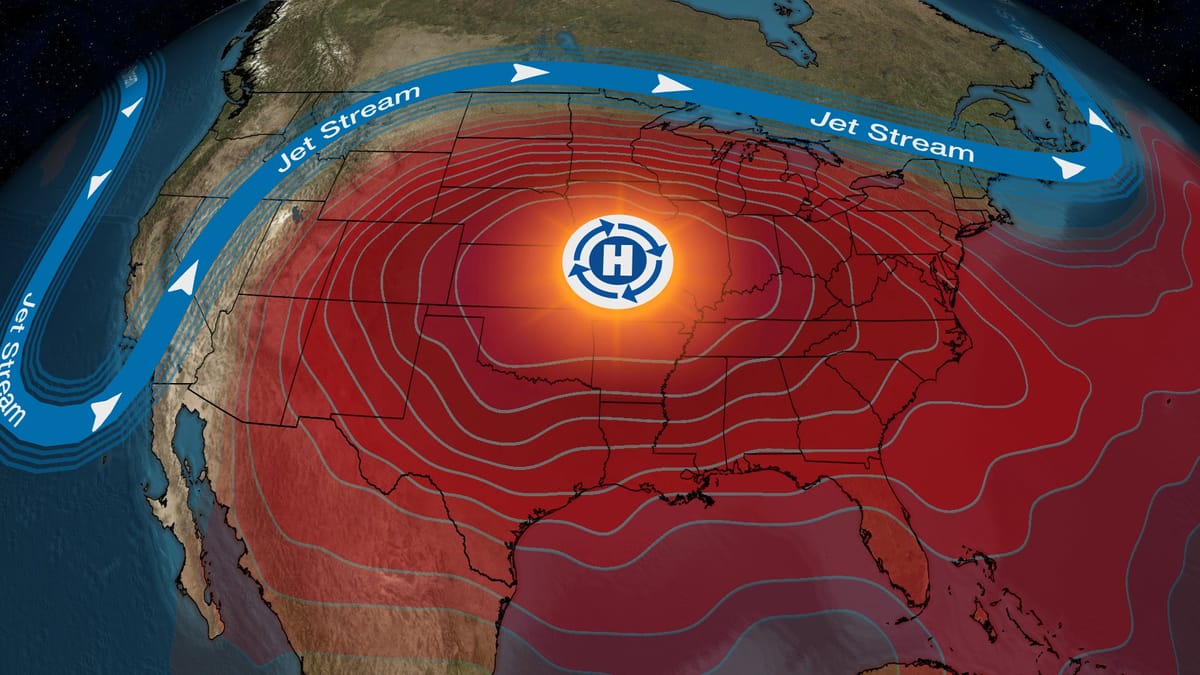Heat Domes: The Silent Killer Intensifying Under Our Noses
Heat domes—massive, high-pressure systems trapping hot air like a lid on a simmering pot—are becoming more frequent and severe yet remain largely misunderstood. It's time to shed light on this deadly phenomenon and confront the uncomfortable truths about our changing climate.

While mainstream media often fixates on dramatic weather events like hurricanes and tornadoes, a more insidious threat is quietly intensifying across the globe. Heat domes - massive, high-pressure systems that trap hot air like a lid on a simmering pot - are becoming more frequent and severe yet remain largely misunderstood by the public.
As temperatures soar and records shatter, it's time to shed light on this deadly phenomenon and confront the uncomfortable truths about our changing climate.
To understand the threat we face, we first need to grasp the mechanics of these meteorological pressure cookers. A heat dome forms when a strong high-pressure system in the upper atmosphere stalls over a region, trapping hot air underneath. This creates a feedback loop: clear skies allow more solar radiation to reach the ground, further intensifying the heat. The trapped warm air can't escape or be replaced by cooler air, leading to prolonged extreme temperatures.
Think of it as nature's cruel version of a greenhouse. These atmospheric phenomena can vary in size, often covering several states or up to half a country, and may persist for days or weeks, depending on atmospheric conditions. It's a recipe for disaster that's becoming all too common.
Heat domes' increased frequency and intensity
If heat domes are the weapon, climate change is the finger on the trigger. Despite what climate change deniers might claim, the link between global warming and heat domes' increased frequency and intensity is undeniable.
Climate change significantly alters the jet stream's behaviour, leading to the more frequent formation of blocking patterns that trap weather systems, including heat domes, over regions for extended periods. This alteration results in prolonged and more intense heat events. A 2023 study revealed a chilling truth: the intensities of hot extremes associated with heat dome-like atmospheric circulations are increasing faster than the background global warming trend.
Let that sink in. We're not just dealing with gradual warming—we're facing a supercharged version of heat extremes that outpace even our worst predictions.
Beyond the Numbers: Real-world impacts on communities and ecosystems
The consequences of these intensifying heat domes extend far beyond uncomfortable summers and higher air conditioning bills. They pose substantial health risks and challenges for affected regions, particularly in urban areas and lower elevations with more pronounced effects.
Agricultural communities face crop failures and livestock losses. Wildfire risks skyrocket. Power grids strain under the demand for cooling, leading to blackouts that can be life-threatening for vulnerable populations. Water sources dry up, exacerbating drought conditions and fueling conflicts over this precious resource.
Ecosystems, too, bear the brunt of these heat extremes. Species that can't adapt quickly enough face local extinctions. Delicate balances in food chains are disrupted. As temperatures rise, we see shifts in plant and animal distributions that could have far-reaching consequences for biodiversity and human livelihoods.
Case Studies: Examining recent heat dome events and their consequences
The abstract becomes painfully concrete when we look at recent heat dome events. In 2021, a heat dome over Canada and the northwestern United States persisted for nearly a month, causing temperatures to soar to a record-breaking 49.6°C (121.3°F) in British Columbia. This wasn't just a new record - it was a shattering of previous highs by margins that left meteorologists in disbelief.
The human toll was devastating. Hundreds died from heat-related causes, many of them elderly or vulnerable individuals living alone. Infrastructure buckled under the strain - roads melted, power lines sagged, and rail lines warped.
More recently, in June 2023, a heat dome extended from Mexico into the southwestern United States, bringing temperatures 20-30°F (11-16.5°C) above normal for that time of year. Cities like Phoenix experienced long stretches of days with temperatures over 110°F (43°C), pushing human endurance and urban infrastructure to their limits.
These aren't isolated incidents. They're a glimpse into a future that's already arriving.
The Urban Heat Island Effect: Why cities are particularly vulnerable
Cities, where most of the world's population now resides, face a double whammy regarding heat domes. The urban heat island effect - where cities are significantly warmer than surrounding rural areas due to heat-absorbing surfaces and lack of vegetation - amplifies the impacts of heat domes.
Concrete jungles become literal ovens, with nighttime temperatures offering little relief. This continuous heat exposure is particularly dangerous, as it prevents the human body from recovering overnight. Low-income neighbourhoods, often with less green space and older housing stock, bear the brunt of this urban heat inequality.
As our cities grow and densify, we inadvertently create perfect conditions for heat-related disasters. It's a ticking time bomb that urban planners and policymakers can no longer ignore.
Health Risks: Understanding the hidden dangers of prolonged extreme heat
The health impacts of heat domes extend far beyond mere discomfort. Extreme heat is a silent killer, often underestimated in its lethality. During intense heat waves, hospitals see spikes in admissions for heat stroke, dehydration, and exacerbation of chronic conditions like heart disease and respiratory ailments.
But the danger isn't limited to direct heat-related illnesses. Prolonged exposure to extreme heat can impair cognitive function, increase aggression, and even lead to higher rates of violent crime. The psychological toll of enduring oppressive heat day after day shouldn't be underestimated either.
Moreover, the most vulnerable members of our society - the elderly, young children, outdoor workers, and those with pre-existing health conditions - face the greatest risks. Heat domes expose and exacerbate societal inequalities in stark and often deadly ways.
Adaptation and Mitigation: What can be done at individual and policy levels?
Both individual action and systemic change are crucial in facing this heated future. On a personal level, creating cooling plans, checking on vulnerable neighbours, and making homes more heat-resistant can save lives. But let's be clear: individual action alone is woefully insufficient in the face of this global threat.
We need bold, ambitious policies to mitigate climate change and adapt to more frequent heat extremes. This means aggressively reducing greenhouse gas emissions, reimagining urban planning to prioritize green spaces and heat-resistant design, and investing in robust public health and emergency response systems.
Moreover, we must address the underlying inequalities that make certain communities more vulnerable to heat extremes. Climate justice and social justice are inextricably linked, and any effective response to heat domes must acknowledge this reality.
Looking Ahead: Projections and worst-case scenarios
The outlook, if we continue on our current trajectory, is grim. Studies predict an increase in 'summer heat-dome-like stationary waves' over northwestern North America and other regions globally. As greenhouse gas emissions continue to rise, scientists expect heat domes to occur more often, last longer, and cover larger areas.
In worst-case scenarios, we could see heat waves pushing beyond human survivability limits in certain regions. The economic costs would be staggering, with productivity plummeting and areas potentially becoming uninhabitable during summer.
But it's crucial to understand that these worst-case scenarios are not inevitable. They're projections based on our current course, and we have the power—and the responsibility—to alter that course.
Conclusion: Turning Up the Heat on Climate Action
As heat domes become our new, sweltering reality, we can no longer afford to ignore their existence or downplay their significance. The intensification of these events outpaces even the most pessimistic climate models, starkly reminding us that the climate crisis is not a future threat but a present emergency.
It's time to turn up the heat on our leaders, demand aggressive action on climate change, and fundamentally rethink how we build resilience in our communities. We need a revolution in approaching energy, urban planning, and global cooperation. The alternative - a world where deadly heat waves become the norm rather than the exception - is simply too hot to handle.
The choice is ours. Will we continue to simmer in denial, or will we break free from this heat dome of inaction? Our response to this challenge will define not just the livability of our planet but the very future of human civilization. It's time to step out of your comfort zone and into the arena of meaningful change. After all, compared to the heat we're facing, the heat of battle for a sustainable future seems downright cool.




